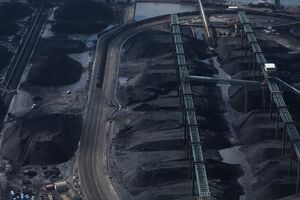Wet Dust Suppression
Water Suppression

Coal dust emissions are primarily managed using wet suppression methods that consist of spraying water over coal storage piles, railcars, and/or transloading equipment using a system of sprinklers. Water application is often adjusted based on terminal activity and the ambient humidity conditions.
Water suppression is mentioned in the record as early as the 1920s, when the Chesapeake and Ohio (C&O) Railroad Company installed a custom pipe system to wet coal-filled railcars where and when the cars were emptied through overturning.[1] Following an air monitoring study in 1956 demonstrating coal was a major portion of airborne dust in Southeast Newport News and pressure from the Newport news City Council, C&O installed equipment to create a water fog over the coal piers to suppress dust.[2]
Today, the coal export terminals continue to rely on water suppression despite community calls for other forms of dust mitigation, particularly a wind fence or dome in Southeast Newport News or railcar coverings in Lambert's Point. The Kinder Morgan Bulk Terminals use a system of 44 sprinklers to spray water that suppresses dust emissions from the piles and transloading equipment.
Chemical Coatings
Documents
References
- ↑ Railroads of Port Adopt Coal Sprinkle: Growing demand for Sprinkled Coal Said to Be Made by Trans-Shippers, Daily Press, November 23, 1927.
- ↑ C&O to Install Costly Equipment for Control of Air Pollution in NN, Daily Press, December 12, 1956.